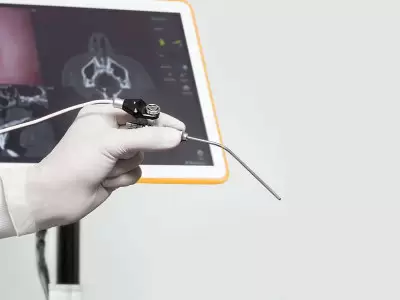Nasal Obstruction
Nose is the normal respiratory organ of the human body and provides heating, humidification of the air that we inhale and filters the foreign substances, allergens and microorganisms inside the air. Oxygen found in the respiratory air can be transferred to the blood circulation better in the lungs when the air is heated and humidified in the nose.
The resistance against the air flow inside the nose during respiration contributes to the good widening of the lower respiratory tract and lungs (naso-pulmonary reflex).
Lower nasal turbinates play an important role in the functioning of the nose. Lower turbinates (concha), containing rich vasculatory content in the tissues under their mucosa, adjusts the heating, humidification and filtering of the respiratory air according to the properties of the environmental air and they also adjust the resistance to be applied against the air flow.
Enlargement of the lower turbinates ( concha hypertrophy ) is one of the main reasons of nasal congestion.
Interventions on lower concha should be performed very carefully due to their critical roles in nasal respiration which is very important for normal body functions and they have to be downsized to provide normal functions but should never be completely removed.
If mouth respiration is performed due to nasal obstruction, then the oxygen of the inhaled air can not be retained sufficiently and the blood oxygen level decreases. Reflexes, developing in response to the perception of decreases in the blood oxygen level by the sensors of the brain and the blood vessels that feed the brain, may cause problems like hypertension, rhythm problems of the heart or heart failure in the long term.
Nasal obstruction also leads problems like frequent throat infections, complaints related to the drying of the throat, sleep disorders and also aggravates snoring and sleep apnea and disrupt the quality of life to a high extent.
The most frequent reasons of nasal obstruction in adults are;
Curving or shifting of the septum, having a cartilaginous and bony structure, located in between the two passages of the nose, to a side ( septum deviation ),
Problems in the region called nasal valve at the entrance of the nose ( nasal valve failure )
Enlargement of inferior nasal turbinates ( concha hypertrophy ).
Intranasal septum deviations may occur as a result of damages in the bone and cartilage development centers due to unnoticed injuries during birth or childhood or due to genetic factors which cause the abnormal development of the septal cartilage and bone during adolescent period. Septal deviations may also occur due to nose fractures.
Nasal valve failure is the narrowing of the angular region (nasal valve) that is found just at the entry of the nasal passage, the region neighboring the side walls of the nose. The problems of this region may affect respiration seriously. Valve failure can occur in two types;
Internal failure: narrowing o the airway passage due to bended septum in the valve region
External failure: Nasal side wall’s cartilaginous support’s being too weak to resist air flow due to its structure or due to minimization in surgeries with esthetic purposes or being concave so as to narrow the valve.
Nasal valve failures are seen objectively with acoustic rhinometry test that enables the calculation of different cross-section areas of different regions within the nasal passage in addition to nasal examination.
In the majority of patients with deviation, enlargement in the nasal turbinates on the opposite side of the deviation is observed. The reason of this is the enlargement of lower turbinates as a consequence of the reflexes developing to provide resistance against the air flow and provide air turbulence to preserve the normal functions of the system (compensatory hypertrophy).
Swelling of nasal mucosa due to allergic reactions is another common reason of nasal obstruction. In patients with allergic rhinitis, itching, sneezing and aqueous, clear nose and post-nasal drainage is also present in addition to congestion.
Nose and sinus infections, extreme reactions of the nasal vessel to external stimuli (vasomotor rhinitis), polyps originating from sinuses, concha bullosa and benign and malign tumors may also result in nasal obstruction.
In children especially after age of 2, the most frequently seen reason of nasal obstruction is enlargement of adenoid. In congenital obstructions, incomplete formation of the nasal passage or obstruction at the back of the passage where it opens to the nasal cavity (atresia of choana) should be considered. Allergy, sinusitis and inserting foreign substances in the nose are less frequent causes of nasal obstruction during childhood.
At nights, the reason for nasal obstruction when lying down is the accumulation of blood in the vessel network found in the lower turbinates. When standing, blood returns back to the heart more comfortably with the effect of the gravity and turbinates shrink in size. When lying down, since the height difference between the heart and the head gets smaller, the support of gravity disappears and blood’s returning back to the heart becomes hard and the blood, accumulating in the lower turbinates result in swelling and nasal obstruction.
In a patient with nasal obstruction, if infection is detected in nose or sinuses with examination and/or radiologically, this infection has to be treated with appropriate medications as the first step of the treatment.
In allergic patients, when appropriate anti-allergic medications are given, the complaint of obstruction may be reduced.
For nasal obstruction due to chronic sinusitis and intranasal polyps, polyps should be removed, discharge channels of the sinuses should be opened and ventilation should be provided with the appropriate surgical method.
Decongestant pills and sprays are used in the early period and for a short time especially in the treatment of upper respiratory tract infections and allergic reactions. These medications cause constriction in the vessels of nasal mucosa and lead to the shrinking of lower turbinates and temporarily eliminates the obstruction. Oral medications also show similar effect by constricting the vessels. Though decongestant drugs in the form of drops and spray provide very good opening in short time, they should be used with care since they lead to widening in the vessels and permanent changes in the surface anatomy of the nasal mucosa in administrations exceeding 5-7 days due to counter-effect. Oral decongestant may cause palpitation, sleep disorder and restlessness in children since they show activity in the entire body. In addition, they should not be used in patients with rhythm disorders of the heart, hypertension, and prostate hyperplasia since they can aggravate the complaints related to these conditions.
The easiest method in understanding the role of lower turbinates in nasal obstruction is decongestant test. If a marked opening in the congestion is obtained 5-10 minutes after spraying a decongestant in the nose, then the congestion results from the lower turbinate. Even if the congestion in a passage is not significantly relieved compared to the other passage after this application, then other pathologies, mainly deviation should be considered. Acoustic rhinometry evaluation that will be performed before and after the decongestant test will demonstrate the role of lower turbinate, especially the anterior tips, numerically.
In patients without allergies and /or infections or in patients whose obstruction complaints are not relieved with medical treatment, surgical treatment options come to the fore.






Comment
Your Contact Information will not be shared in any way. * Required Fields